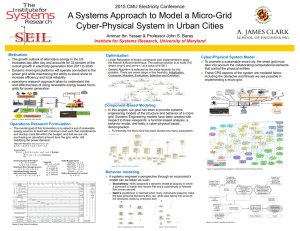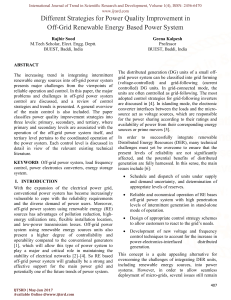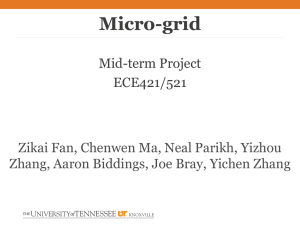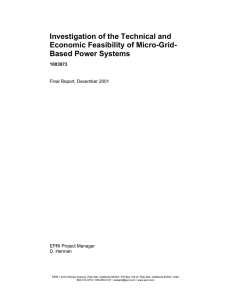M d li d E ti ti f Mi
advertisement
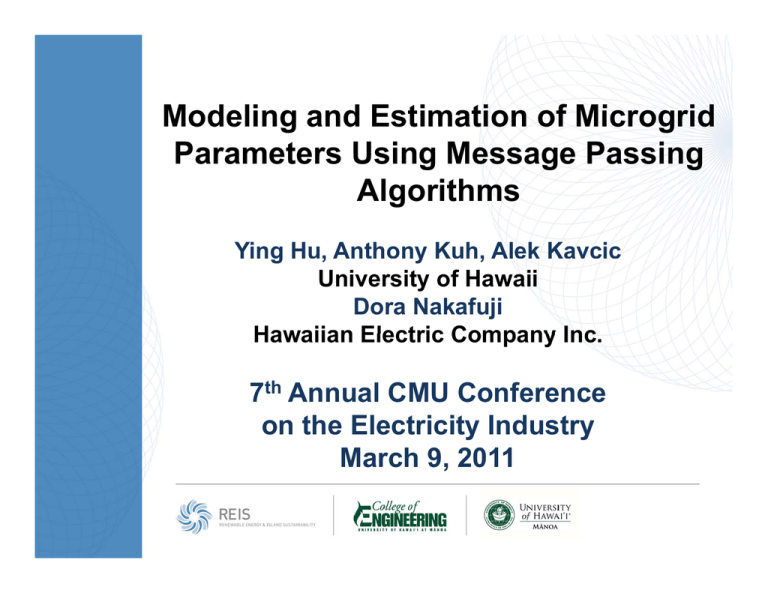
Modeling M d li and d Estimation E ti ti off Microgrid Mi id Parameters Using Message Passing Al Algorithms ith Ying g Hu,, Anthony y Kuh,, Alek Kavcic University of Hawaii Dora Nakafuji Hawaiian Electric Company Inc Inc. 7th Annual CMU Conference on the Electricity Industry March 9, 2011 Outline • Hawaii Energy Landscape (HCEI) • Micro-grid Micro grid Project – State Estimation – Model micro-grid as a factor graph • Probabilistic modeling • Measurement devices • State vector ecto ((for o g grid d nodes) odes) – Message Passing (Belief propagation) for micro-grids • Summary and Further Directions Slide 2 DN1 Suggest not limiting talk to AMI and PMU as we're deploying a number of other devices. AMI is not a silver bullet Dora Nakafuji, 12/14/2010 CA & HI Energy Source: CEC 2008 & HECO 2008 California • • • Primary resource is natural gas, 80% imported from other states & Canada Top 10 generation plants are gas, nuclear and hydro resources Nearly 25% of electricity consumed is imported from neighboring states Hawaii • • • Primary resource is petroleum, 90% imported (30% for electricity, 60% transportation) Top 10 generation plants are petroleum, coal, and waste resources Islanded systems HCEI (Hawaii Clean Energy Initiative) 70% clean energy gy ((30% efficiency, y, 40% RE)) by y 2030 • Conserve: Use what we need efficiently – Commit to more energy efficient lifestyle at home and on road – Establish energy efficient building codes and lower energy usage at work and schools • Convert: Harness what we have wisely – Stop building fossil fuel plants – Generate 40% of energy locally – Harness energy from solar, wind, ocean, geothermal, and biomass resources – Establish E t bli h a sustainable t i bl alternative lt ti fuel f l strategy t t – Embrace hybrid and electric vehicles – Modernize our power grid system Hawaii projects • Interisland cable and wind farms on Lanai and M l k i Molokai • Electrical vehicles, PHEV adoption • Energy efficiency • Distributed PV on rooftops • Biofuels • Other renewable sources: geothermal, wave, OTEC, hydro • Military projects • DOE workforce training grants, solar decathlon 5 Smart Grid Research Topics • • • • Data acquisition, assessment, and visualization Modeling and estimation Optimization, control, pricing, and security I f Informed d consumers and d social i l impacts i t 6 Slide 6 DN2 replaced management with assessment as it seems more appropriate for UH to assess and analyze. Data mining techniques is another need but not discussed... management seems too trivial. Dora Nakafuji, 12/14/2010 M d li and Modeling d Estimation E i i • • Traditional Modeling and Estimation – State estimation usually studied at transmission level – Base on Maximum Likelihood Estimation (MLE) using Weighted Least Squares (WLS) algorithm – Pseudo-measurements introduced Micro-grid Modeling and Estimation – Requires resolution of distribution level with system impacts at the transmission level – Currently not well monitored (need additional sensing devices, i.e. AMI) – Accommodates distributed control (utilities, end users, smart d i aggregators) device t ) – Sparse measurements, use Bayesian network models 7 Micro-grids • • Expand pa d grid g d responsiveness espo s e ess beyo beyond d last ast substation substat o with t communication and control (distribution system) Characteristics • Increased distributed renewable energy generation (solar (solar, wind) • More sensing and monitoring (grid level and home level using building management systems and AMI) • Offer cost effective, near-term strategy to strategically locate and deploy control and response features at key vantage points on the system Slide 8 DN3 Not sure if I'm missing the point but the rational and primary value for having this done is missing. Revised this bullet to capture the premise which I believe was use the models to develop correlations and inform deploy of monitoring at key vantage points...seems missing from this talk as a key advantage and value of this method. Dora Nakafuji, 12/14/2010 Probabilistic Modeling • • • • • • • Equations governing grid parameters Demand is random but has a time of use pattern p Distributed RE generation is intermittent and random Correlations between distributed RE generation (temporal and spatial) Sensing devices sample parameters at some key nodes (substation-level, DG resource, building) Use statistical inference methods to estimate parameters at other nodes and verify using field measurements Develop realistic clusters or micro-grid representations (load generation & resource profiles) for modeling of the (load, grid vs simplified nodal representations Distributed System: Bus Branch Model Regionallevel Control Local level Control 10 Factor graph of micro-grid Parameters of Factor Graph ☐ represents functions of variables (factor function) g – describing dependence of variable on voltage controlled bus fE – describing electrical relationship at the bus fL – describing d ibi distribution di t ib ti line li fT – describing transformer fS – describing solar temporal and spatial correlations fW – describing wind temporal and spatial correlations |represents state variables of micro-grid Δ represents observed variables, yy’ss have metering devices (e.g. AMI, solar monitoring) 12 Probabilistic modeling continued • Variables are random vectors giving key parameters of grid (power, reactance, voltage, and current) • Observation variables: y’s • State variables: x’s • If all functions are linear and observations are sampled, then we can model as a discrete time state space model – x(k+1) = A x(k) + b u(k) state equation – y(k) = c x(k) + dv(k) observation equation Kalman Filter • Want to come up with an estimate of the posterior probability of x x’s s given y’s ys • Use a linear mean squared error cost criterion and recursively update your estimate which results in a Kalman filter • Computes conditional mean estimate and conditional covariance matrices Model Considerations • Electrical g grid: use complex p voltage g and complex p current as state vector, edges modeled by complex impedence, use KVL and KCL • Model M d l distributed di t ib t d renewable bl sources (power) ( ) • Model loads as Gaussian random variables (from data gathered) • Need efficient method to perform computations 15 Distributed Renewable Energy Modeling • Spatial and temporal correlations: model (solar, wind power) as vector AR (VAR) process Z(k) = Σ Ai Z(k-i) + V(k) Extensions Markov switched VAR, VARMA, VARIMA process (preliminary studies on solar insolation data show Ai are diagonally dominant) • Integrate I t t renewable bl energy power into i t model d l into i t model equations, power contribution not linear, need to linearize and iterate • Distributed sources more variable and intermittent (determine sampling rate) 16 Belief Propagation • An efficient way of computing marginal and conditional probabilities • Also called message passing or the sum / product algorithm g • Computations are local and distributed • Can be used to compute discrete valued random variables i bl or Gaussian G i random d variables i bl (compute ( t first and second order statistics) • Has been applied in communications, signal and image processing, and computer science applications Message g Passing g Rules (Sum-Product) ( ) • Compute marginal and conditional probabilities using a system of message passing on factor graph: • a) Message from variable node n to factor node m: vn,m(x ( n) = ∏ μi,n(x ( n) • b) Message from factor node m to variable node n: μm,n(xn) = ∑ [fs(xN(s)) ∏ vi,m(xi)] • Each node passes a message to neighbor when it has received a message g from all other adjacent j nodes. 18 B li f Propagation Belief P ti for f the th Micro-grid Mi id • • • • • Define state variables for node locations (complex voltage, complex l current) t) and d sampling li rate t For electrical power grid most networks can be modeled as a tree (factor graph uses KVL and KCL and has loops) run l loopy BP which hi h still till converges on simulations i l ti For renewable energy generation (correlations create loops in graph) run loopy BP which still converges on simulations i l ti Flooding algorithm used where observations are presented and then updates are made until convergence Method needed for implementation of algorithm (how do nodes communicate information) Summary • Micro-grid including distributed renewable energy generation ti and d sensing i modeled d l d using i factor f t graph • State variables of current and voltage used with RE power accounted for by linear approximation • Models for RE correlations formulated to account f spatial for i l and d temporall correlations l i • Statistical inference performed using belief propagation (parallel flooding algorithm) • Preliminary simulations performed establishing correctness of model 20 Further Directions • Validate temporal and spatial correlation models f wind for i d and d solar l resource and d grid id data d t • Get real load data at the node level (end use) • Validate model on a real micro-grid • Algorithm can then be used for – Development of distributed control algorithms – Address anomaly detection – Understand the effects of distributed renewable generation (i.e. g ( at what levels do distributed PV affect the stability of the micro grid) 21 Slide 21 DN4 Is this something UH is working on or someone else? I don't necessarily see this as fitting your talk. Is certainly a need but not sure how connected to this research. Dora Nakafuji, 12/14/2010 C Contact iinformation f i • REIS homepage: http://reis http://reis.manoa.hawaii.edu manoa hawaii edu • Tony Kuh: 956-7527, kuh@hawaii.edu Mahalo!!
